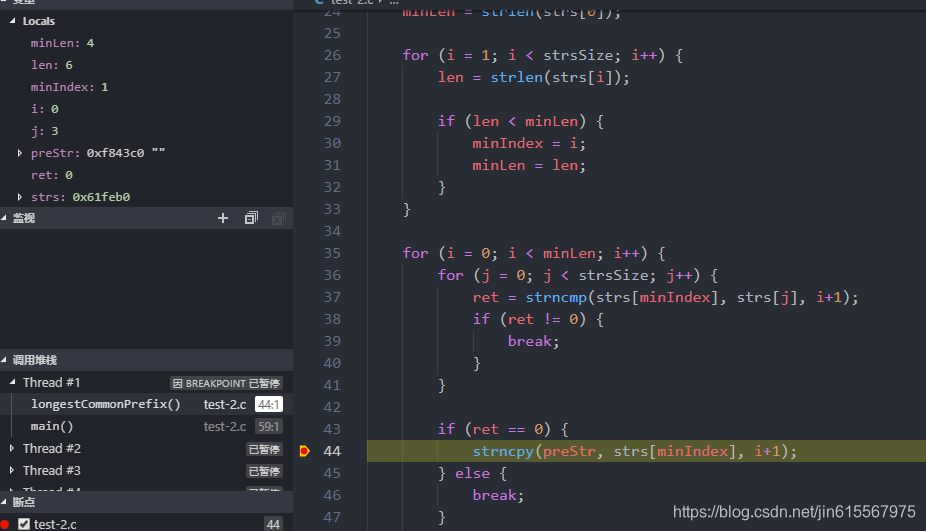LeetCode上面写的代码有时候出错了,非常不好定位,只能printf打印,而不能单步调试和设置断点。
能不能本地IDE调试LeetCode代码呢?当然能,例如现在用vscode来调试LeetCode代码。
首先得电脑得安装gcc,vscode配置好gcc和gdb,网上教程非常多,这里不详细说明了。
然后就是添加对应头文件:
#include <ctype.h>
#include <math.h>
#include <stdint.h>
#include <stdio.h>
#include <stdlib.h>
#include <string.h>
#include <sys/types.h>接着就是写个main函数调用LeetCode的函数了,但是这里需要小心二维数组传参处理。
以
14. 最长公共前缀(E)
,这道题为例,整个文件代码如下:
#include <securec.h>
#include <ctype.h>
#include <math.h>
#include <stdint.h>
#include <stdio.h>
#include <stdlib.h>
#include <string.h>
#include <sys/types.h>
char * longestCommonPrefix(char ** strs, int strsSize) {
int minLen;
int len;
int minIndex = 0;
int i, j;
char *preStr = malloc(1024);
int ret = 0;
memset(preStr, 0, 1024);
if (strsSize == 0) {
return preStr;
}
minLen = strlen(strs[0]);
for (i = 1; i < strsSize; i++) {
len = strlen(strs[i]);
if (len < minLen) {
minIndex = i;
minLen = len;
}
}
for (i = 0; i < minLen; i++) {
for (j = 0; j < strsSize; j++) {
ret = strncmp(strs[minIndex], strs[j], i+1);
if (ret != 0) {
break;
}
}
if (ret == 0) {
strncpy(preStr, strs[minIndex], i+1);
} else {
break;
}
}
return preStr;
}
int main(){
char strs[3][32] = {"flower","flow","flight"};
int strsSize = 3;
char *p[3] = {strs[0], strs[1], strs[2]};
longestCommonPrefix(p, strsSize);
while (1) {}
return 0;
}main函数里调用longestCommonPrefix函数(leetcode要求实现的),填充要求的strs参数和strsSize。
strsSize参数好说,strs不能直接传二维数组进去,需要借用指针数组p先转换一下,然后传p指针进去。
接着就可以打断点,单步调试了,爽:

如果是其他OJ平台呢,直接scanf给的输入参数。
那更简单了,用一个文本重定向函数 freopen 就解决了,把所有输入都放入in.txt文本中:
freopen(“in.txt”, “r”, stdin); // 文本文件重定向到标准输入
版权声明:本文为jin615567975原创文章,遵循 CC 4.0 BY-SA 版权协议,转载请附上原文出处链接和本声明。